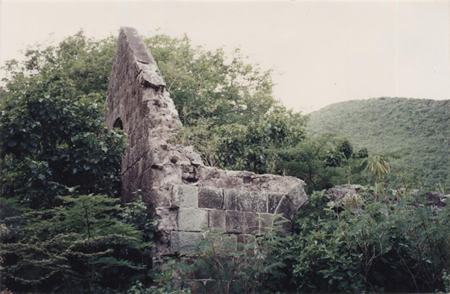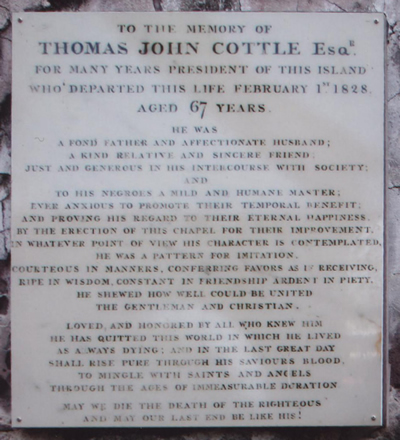

In the 1980s the Cottle Church was a romantic and mysterious ruin visited only by the more intrepid islanders and visitors.
 In a dry season it could be seen from a distance easily enough but after rains it was quite difficult to find, hidden by vegetation which barred you from approaching close to it without a cutlass to hand. The church lies on the Round Hill Estate not far from the airport and is owned by the local Chaderton family.
In a dry season it could be seen from a distance easily enough but after rains it was quite difficult to find, hidden by vegetation which barred you from approaching close to it without a cutlass to hand. The church lies on the Round Hill Estate not far from the airport and is owned by the local Chaderton family.
Those who knew of it and its significance were conscious that it could soon be swallowed up entirely by the bush like so many Nevisian ruins. Storms and hurricanes were destroying its remaining walls and gables.
The Chaderton family generously granted a 20 year lease on the half acre site to the UK Trust. The ruin was to be preserved as a historical monument for the public to visit. Church and community groups were to be encouraged to hold meetings and picnics on the site.
Year by year the bush was gradually tamed and vegetation was regularly stripped from the walls of the ruin. Children from the the local Combermere School made expeditions to help with the clean up. Constant cutting back of the bush and mowing of the grass eventually produced a green sward surrounding the ruin.
By 1999 enough funds had been raised to make a start on stabilizing the structure. A British based historical architect drew up plans. The priorities were to support the two existing gables at either end of the transept which were in imminent danger of collapse. Temporary buttresses were put in place just before Hurricane Georges hit the island.
Once this temporary relief was gained the question arose what did conserving the ruin mean? For some people this meant recreating the church as it was built in the 1820s. A benefactor of the project had made a computerised model showing exactly how the church was built (see below). There were still people on the island who could remember the church as it was before World War II, with the roof in place, the organ inside and headstones in the grounds. For others the image of the church was of a romantic ruin as depicted by artists like Eva Wilkin and Dorothy Cleary. By 1999 no one alive had seen the church in its previous states.
The Trust decided that the ruin should be stabilized as it was in 1999. Features would be restored only for structural reasons, that is, where without repair and replacement of missing stones the future of the structure itself would be at risk. Some arches would be wholly restored to show the design of the building but others should be stabilized to prevent any further deterioration.
Missing stones were replaced using similar lime based mortar to that used in the original construction. To give greater stability to the whole structure a concrete ringbeam was installed and concealed around the top of the walls. Finally in 2002 the temporary buttresses were removed and the gables supported were supported from within the walls.
Archaeology students from the University of Southampton surveyed the grounds around the church and confirmed that the grounds had been used for burials.
 Through research at the UK National Archives it was possible to discover the names of all the workers on the estate at the time when the church was built. Among these would have been the stonemasons and carpenters who had built the church. A commemorative plaque giving their names hangs on a wall of the church.
Through research at the UK National Archives it was possible to discover the names of all the workers on the estate at the time when the church was built. Among these would have been the stonemasons and carpenters who had built the church. A commemorative plaque giving their names hangs on a wall of the church.
On his death in 1828 a memorial tablet had been erected to Thomas Cottle. This had been taken to St Thomas' Church for safekeeping after the church had become a ruin. A copy of of this tablet now hangs where the original was originally placed.
In the grounds close to the church a small pavilion was built as an information centre displaying biographies of notable figures of the time and a history of the church. The pavilion is dedicated to the Rev George Walker, whose booklet on the church (1990) provided the inspiration for the conservation project.
Today the church and its grounds are used by the public for worship and recreation. Weddings and school picnics are held. Talks are given to school children to explain the history and significance of the site.
“A lovely setting"
“Beautiful, peaceful location - quite emotional”
“Quiet and contemplative”
“Interesting history”
“First integrated church in the caribbean”
| Read reviews | ||
 |
||
| Share this site | ||
More about The Cottle Church:
The history
Key figures in the Church's history
Visiting the Church
© Nevis Historical and Conservation Society. All rights reserved. Designed by Creative-i-Design